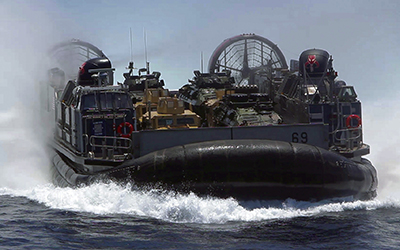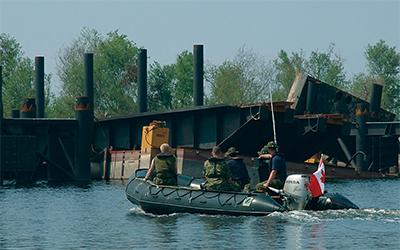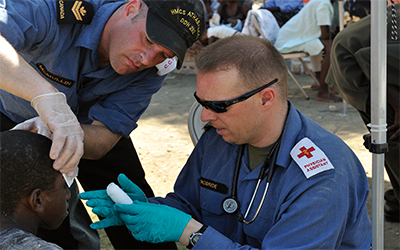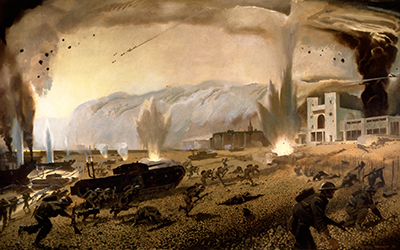Views and Opinions

DVIDS photo 913597 by Corporal Kyle N. Runnels
US marines and sailors conducting amphibious training aboard a landing craft air cushioned vessel, 20 April 2013.
Reducing Reliance and Enhancing Relationships: The Benefits of a Canadian Amphibious Capability
by Christopher Hartwick
For more information on accessing this file, please visit our help page.
“The fact that the future is uncertain is no excuse for failing to make adequate preparations.”1
Introduction
Canada has the longest coastline on the planet and a proud maritime heritage. However, it is the only Group of 8 (G8) country without an amphibious capability.2 In fact, despite participating in amphibious operations in the past, Canada has never had its own naval infantry or marine corps.3 In order to project its military power across the seas and provide adequate coastal defence for Canada,4 the Canadian Armed Forces (CAF) is dependent upon its many allies for assistance. In the early-2000s, the purchasing of amphibious assault ships was examined and lead to the establishment of the Standing Contingency Task Force (SCTF) Integrated Tactical Effects Experiment (ITEEX) project in 2005. The goal of the project was to identify the requirements for a potential Canadian expeditionary quick reaction force with an amphibious capability.5 The SCTF was to be composed: “Of air, land and sea forces, to be available upon 10 days notice to deploy on expeditionary operations under a single commander.”6 The project was articulated in Ottawa’s 2005 defence policy, and was even a priority for the then-Chief of Defence Staff, General Rick Hillier.7 In November 2006, a large-scale experimental amphibious exercise was conducted at U.S. Marine Corps Base Camp Lejeune, North Carolina. The exercise cost the CAF 19 million dollars, and consisted of 1100 Canadian soldiers in conjunction with CAF helicopters, Light Armored Vehicles, and shipping on loan from the United States (US).8 National Defence Headquarters, however, ordered a halt to the project in April of 2007 because of fiscal limitations.9
Discussion
An amphibious capability is not something that Canada wants, but is something that Canada needs. In today’s chaotic and uncertain security environment, there will be situations which arise in regions of the world that will not be conducive to flying in conventional forces, and the requirement for Canada to possess an amphibious capability will be paramount. The metrics of a Canadian amphibious capability have already been examined during the SCTF ITEEX project and in previous journal articles,10 so they will not be revisited within these pages. Instead, a more conceptual lens will be applied and aimed at highlighting how an amphibious capability would improve the CAF’s ability to better enforce national security, enhance combined force interoperability, reduce its reliance upon allied nation forces, and become a more robust contributor to international operations.
Currently, the CAF is overextended when it comes to enforcing national security along Canada’s three coastlines, and an amphibious capability would enhance its ability to fulfill this national interest. Canada’s navy, while modern and highly responsive, is relatively small, lacks year-round icebreaking capabilities, and is dependent upon operational seaports, which some have argued makes it inadequate to defend Canada’s coastline.11 By placing rapid reaction amphibious forces on Canada’s coasts, the CAF would be better prepared to deal with any natural disasters that might occur in littoral regions, even if Canadian airfields and seaports in the area are rendered non-operational. Once Canada’s new Arctic Offshore Patrol Ships (AOPS) are brought into service,12 the same concept could be applied to the arctic, where populations are scattered and infrastructure is limited. In terms of coastal defence, an amphibious force could be dispatched to the arctic to assist in defending from a threat to Canada’s arctic sovereignty.
While the adoption of an amphibious capability will certainly enhance the joint interoperability between the CAF’s air, land, and sea elements, the greater payoff will be the interoperability Canada will gain with its amphibious allies. The CAF has maintained a high degree of interoperability through combined operations under the North American Aerospace Defense Command,13 North Atlantic Treaty Organization, and by contributing forces to numerous naval Multinational Interception Forces.14 The CAF also participates in multinational exercises, such as Exercise Rimpac.15 More recently, the CAF participated in Exercise Bold Alligator16 and Exercise Southern Katipo,17 where Canadian soldiers conducted amphibious warfare training with a number of different forces from around the world. Although the Royal Canadian Navy is viewed as “…the most interoperable medium-size navy in the world”18 in ‘blue water’ operations, it absolutely requires its own amphibious ships and connectors to be relevant in operating with Canada’s allies in ‘green’ and ‘brown water’ operations. Understandably, acquiring the required sea vessels and equipment will be difficult, but the brunt of the work will actually lie with the building of relationships and trust between allied forces.19
Training forces to conduct amphibious operations in permissive environments is a complex undertaking on its own,20 and is not something that should be surged in an ad hoc fashion. Therefore, it would behoove Canada to develop and maintain an amphibious force sooner rather than later. That would result in Canada having a ready and interoperable amphibious capability that would enhance the CAF’s ability to collaborate with its allies.

DND photo HS2005-G002-04 by Master Corporal Colin Kelley
Canadian divers check out some of the damage from Hurricane Katrina in the New Orleans area, 14 September 2005.
Canada currently relies upon its allies to assist with ship-to-shore movement in regions where functional infrastructure is unavailable. Having an amphibious capability would reduce the CAF’s dependency upon its allies to move forces and supplies into an area of operations. As Canada has no troop transport ships, when operating independently, the CAF are restricted to airlift for moving land forces into expeditionary environments.21 Ergo, when serviceable infrastructure is not available, the CAF’s involvement in operations becomes limited. For instance, Operation Unison in 2005, tasked to assist the US after Hurricane Katrina, and Operation Hestia in 2010, tasked to assist Haiti, are two examples of where the CAF had to rely upon the capabilities of other nations. In both cases, functional infrastructure was not available, and assistance from the US Navy to move supplies and personnel off Canadian ships was required.22 Had Canada possessed its own amphibious capability, it would have been able to project its forces ashore without assistance. Furthermore, in the case of Operation Unison, it would not have required the help of the nation it was there to assist.

DND photo HS2010-C010-028 by Corporal Johanie Maheu
Master Seaman Phil McMullin (left) and Warrant Officer John McBride of HMCS Athabaskan provide medical aid to a little boy at the Canadian camp in Leogane, Haiti, in support of Operation Hestia, 22 January 2010.
An amphibious capability will make the CAF a more robust and reliable contributor to international operations. This capability would provide the advantage of operating from international waters, leading to fewer restrictions on operations. For example, during a Non-combative Evacuation Operation (NEO), any force which is at least 12 nautical miles offshore is not required to coordinate its actions with the country it is sending forces into until its forces are ashore. This would reduce the overall amount of coordination required for NEO-type operations, and would therefore allow forces to react more quickly. Furthermore, amphibious shipping can be an effective intermediate staging base and/or a temporary safe haven for evacuees during NEO operations, instead of having to coordinate with other nations to meet these requirements. The other advantage to having an amphibious capability is the capacity to economically move and deliver bulk supplies and heavy equipment into an area of operations; an extremely costly and limited option when conducted by air, and impossible without functioning airports. With all the advantages that an amphibious capability provides, it is a wonder why Canada has not adopted this capability like so many of its allies.
There are, most likely, those who would be opposed to developing an amphibious capability in Canada because it would constitute such a large institutional change. However, one can argue that the true reason Canada has not yet adopted an amphibious capability is due to fiscal constraints, and the fact that it is not specifically mentioned in Canada’s defense policy. A growth in the force, the procurement of ships, connector vessels, amphibious vehicles, aircraft, training, and the research and development for it all comes with a price-tag which Canada currently cannot afford. In terms of capabilities, finances, and personnel, the CAF is already “over-stretched everywhere,”23 and has invested a great amount of funds into AOPS and cyber warfare development.24 In fact, the Canadian Government is continually cutting back the number of AOPSs that will be produced because of budgetary problems,25 and the CAF are looking for creative ways to ‘grow’ Canada’s cyber warfare capability without increasing the overall number of the force.

CWM 19710261-2183, Beaverbrook Collection of War Art, Canadian War Museum
Dieppe Raid by Charles Comfort
An amphibious capability would prove to be a sound investment, since it is something Canada has used in the past, could have used recently, and will be required to use in future operations. Canadian soldiers stormed the beaches of Dieppe in 1942, and from that raid, hard lessons were learned which led to success for the Allies when Canada again stormed Juno Beach on 6 June 1944.26 More recently, between the years 1949 and 2005, nine Canadian NEOs occurred where ships were sailed; two of them involving the deployment of land forces.27 As discussed earlier, an amphibious capability would have been beneficial during Operations Hestia and Unison to provide humanitarian assistance and disaster relief. Lastly, an amphibious capability is not specifically mentioned in Canada’s 2008 defence policy, but it would certainly enhance the CAF’s ability to complete the six core missions laid out in its pages.28 This is especially true when it comes to Missions Three, Four, and Six: namely, to respond to a major terrorist attack, to support civilian authorities during a crisis in Canada, and to deploy forces in response to crises elsewhere in the world.29
Conclusion
Canada shares many of the same international interests as its allies, and regularly participates in international security and relief operations. However, by being the only G8 nation without an amphibious capability, Canada is diminishing its political significance on the world stage by limiting its military involvement to certain operations. The global security situation is ever-changing, and the human population is estimated to grow to 9.1 billion by the year 2025, of which 60 percent will be concentrated in littoral regions.30 Therefore, one can imagine myriad situations where Canada will have to intervene in these regions, and in order to do so, an amphibious capability will be a necessity. Canada’s amphibious capability would improve national security, interoperability between its allies, reduce Canada’s reliance upon other nations, and allow for the projection of a more robust force into different theatres globally. There is no denying the current fiscal constraints, but there is also no denying the fact that so many of Canada’s allies agree that an amphibious capability brings with it enhanced flexibility to conduct military operations and the ability to further collaborate with allied nations on matters of global importance.
Captain Christopher Hartwick, an infantry officer, is currently posted to CFB Shilo, Manitoba, where he is the Operations Officer for 2PPCLI. He is a 2014 graduate of the United States Marine Corps Expeditionary Warfare School in Quantico, Virginia.

DVIDS photo 2049274 by Petty Officer 2nd Class Daniel Young
US Marines practice an amphibious assault using assault amphibious vehicles during Exercise Talisman Sabre at Fog Bay, Australia, 8 July 2015.
Notes
- United States Department of Defense, United States Marine Corps, Operational Maneuver from the Sea: A Concept for the Projection of Naval Power Ashore (Washington: Department of the Navy, Headquarters US Marine Corps, 1996), p. 5.
- A.M. Paddock, “Advancing Littoral Operations – Transport Connectors for the Standing Contingency Force,” Canadian Forces College, last modified unknown, at http://www.cfc.forces.gc.ca/259/290/293/287/paddock.pdf, p. 5.
- Kenneth P. Hansen, “Army theory and naval practices seldom meet in amphibious operations,” in Canadian Naval Review 8, No. 2 (2007), at http://www.journal.forces.gc.ca/vo8/no2/hansen-eng.asp, p.1.
- W.A.B. Douglas, The RCN In Transition, 1910-1985 (Vancouver: University of British Columbia Press, 1988), p. 316.
- Victoria, “Ottawa Eyes Rapid-Reaction Force,” Canada.com, last modified 18 November 2006, at http://www.canada.com/story.html?id=1f109d87-a204-4ac0-83cb-d5e6ad2c4127, p. 1.
- Les Mader, “Reviving the Princes- Some Thoughts on a Canadian Standing Contingency Task Force,” in Canadian Military Journal, Vol. 7, No. 2 (2005), at http://www.journal.forces.gc.ca/vo7/no2/mader-eng.asp, p. 2.
- Victoria, Ottawa Eyes Rapid-Reaction Force, p. 1.
- Ibid, p.1.
- Canadian Department of Defence, CANFORGEN 059/07 CDS 013/07: INTEGRATED SEA-LAND-AIR EFFECTS CONCEPT DEVELOPMENT AND EXPERIMENTATION (Ottawa: 2007), p. 1.
- Victoria, Ottawa Eyes Rapid-Reaction Force, p.1; Mader, Reviving the Princes- Some Thoughts on a Canadian Standing Contingency Task Force, pp. 9-10.
- Wayne C. Thompson, Canada, 21st Edition. (Harpers Ferry, WV: Stryker-Post Publications, 2005), p. 143; Brian Wentzell, “Making Waves: A Necessary Capability,” in Canadian Naval Review 8, No. 4 (2013), at: http://www.navalreview.ca/wp-content/uploads/public/vol8num4/vol8num4art8.pdf, p. 32; Douglas, The RCN in Transition, p. 316.
- Canadian Broadcasting Corporation, New Ships for Navy, Coast Guard: National Shipbuilding Procurement Strategy to Cost $38.6 Billion, last modified 13 November 2013, at http://www.cbc.ca/news2/interactives/shipbuilding/.
- Thompson, Canada, p. 145.
- Gary E. Weir, You Cannot Surge Trust, Combined naval operations of the Royal Australian Navy, Canadian Navy, and United States Navy, 1991-2003 (Washington: Naval History and Heritage Command, 2013), p. 193.
- Ibid, p. 215.
- Government of Canada, Canadian Soldiers Take Part in Major Multinational Amphibious Exercise Bold Alligator 2014, last modified 8 January 2015, at http://www.army-armee.forces.gc.ca/en/news-publications/national-news-details- no-menu.page?doc=video-canadian-soldiers-take-part-in-major-multinational-amphibious-exercise-bold-alligator-2014/i3yaqfbd.
- David Pugliese, “Canadian Army Learns Amphibious Warfare Exercises in New Zealand,” in The Ottawa Citizen, 18 May 2014, at http://ottawacitizen.com/news/national/defence-watch/canadian-army-learns-amphibious-warfare-exercises-in-new-zealand.
- Weir, You Cannot Surge Trust, p. 213.
- Ibid, pp. 296-297.; Brian Wentzell, “Reflections on the Canadian Amphibious Task Force,” in Canadian Naval Review 2, No. 4 (2007), at http://www.navalreview.ca/wp-content/uploads/public/vol2num4/vol2num4art4.pdf, p. 15.
- Wentzell, Making Waves, p. 31.
- Ibid, p. 32.
- Ibid, p. 31; R.D. Bradford, “The Amphibious Emergency Capability,” in Canadian Naval Review 5, No. 4 (2010), at: http://www.navalreview.ca/wp-content/uploads/public/vol5num4/vol5num4art4.pdf, p. 21.
- Thompson, Canada, p.144.
- Alistair MacDonald and Paul Vieira, “Canada to Beef Up Its Cyber Defenses,” in The Wall Street Journal, 17 October 2012, at: http://www.wsj.com/articles/SB10000872396390444592704578062744030325244, p. 1.; Andrew Vaughan, “Arctic Patrol Ships Budget ‘Insufficient’ to Buy 6 Vessels: PBO, Parliamentary Budget Officer Report Concludes $3.1 Billion Would Only Pay for Four Ships,” CBC, 28 October 2014, at: http://www.cbc.ca/news/politics/arctic-patrol-ships-budget-insufficient-to-buy-6-vessels-pbo-1.2815446, p. 1.
- Vaughan, Arctic Patrol Ships Budget ‘Insufficient,’ p. 1.
- Mark Grimsley, “…the Dieppe Raid had Succeeded?,” ProQuest Military Collection (2011), at http://search.proquest.com.lomc.idm.oclc.org/military/docview/
1267075418/574C413E279E4150PQ/4?accountid=14746. - Mader, Reviving the Princes, p. 3.
- Department of National Defence, Canada First Defence Strategy (Ottawa: 2008), p. 10.
- Ibid.
- United States Marine Corps, Amphibious Operations in the 21st Century (Washington: United States Marine Corps, 2009), p. 2.







